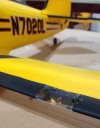Ok... while on the surface it appears to be a simple question... it is about a technical subject and like most of these, there is no one answer that can be given. First I'll mention what you technically must know so you can get the proper answer to your question and hopefully then be able to find the specific information for the model you have.
The first thing you must look for or provide is the exact brand of the RC model and the specific model name and or size... and I don't mean that it is a Waco but which one and/or how big it is etc. Why? Because Waco ( the company ) made about 62 airplanes during its operation between 1919 to 1947 and many of them were biplanes. A lot of RC plane manufacturers have made models of these different ones and some have made different models with different sizes. So the exact RC brand and exact model number of the one you have is required so you can get the proper technical info you need so you don't mess up the LED's or in your case the receiver which they were never meant to be plugged into probably unless they made a unique controller just for that purpose.
About LED's ... the typical ones have different voltages ranging from 1.8v up through 3.3v. Notice I used the word typical because there are many that are not typical also. Often the voltage they require is indicated by their color with red having a 1.8-2.1v requirements and white ones the higher values but as I mentioned, they do vary so you, if having to figure it out without any instructions at all... would need to figure out what the forward voltage of each LED is, to be able to calculate what the power requirements you need are. The simplest circuits are designed in series or parallel and will have some resistors placed in it and you just then supply the DC voltage directly that they require. Most of the better circuits for lights on an RC airplane also include some blinking function built into them, so then you'd need to know more about how that is designed and what voltages that would require you to provide.
Most RC airplane light circuits will ask that you just plug in a certain amount of DC voltage but how much that is is dependent on the design of the circuit they are using. How much voltage they want will likely be whatever was common for the types of batteries being used in the RC industry at the time they made the circuit so that will help you put some limits on what they could possibly be. Examples... typical AA batteries ( of which are sometimes commonly used for additional devices in RC aircraft ) are 1.5v each with a typical pack of 4 would indicate 6v. NiCad and NiMH batteries are typically 1.2v each with a 4 pack providing 4.8v and these days LiPo's are common battery sources with their nominal voltage typically being 3.6v/3.7v and fully charged voltage of 4.2v per cell... the total voltage they can provide would then depend on the number of battery cells they use. So that limits what voltages you may be looking for to multiples of the voltages that each of those battery can types can provide.
Last bit of info... About RC receivers ... they are NOT a power source for you to just plug whatever you want into them. Plugging something into them that they are not designed to have could result in you killing your receiver. The black ( ground lead ) and red ( positive lead ) that you mentioned indicates they are meant to be plugged into a power source that can provide the voltage that circuit was designed for. Had the LED's been designed to be plugged into a typical RC receiver they would have had a compatible plug for a receiver on them. If you did have a LED controller that was designed to be controlled by a receiver you would still need to provide additional power ( voltage ) that could be used to drive the LED's from as well as a RC receiver plug so those lights could be turned on/off.
![20230515_050140[1].jpg](/data/attachments/20/20398-2ed8f10cc9bfa9ca9cafc1e71a478d36.jpg?hash=LtjxDMm_qc)
